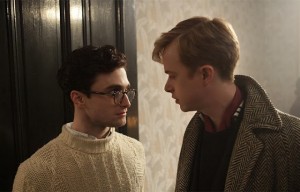film review: kill your darlings
I loved this film. While it is full to the brim of self-indulgent bohemians who cannot see past their own egos, the heroes were exactly what that time in history needed.
The film begins with Daniel Radcliffe (who, despite playing a bespectacled student, turned in an exceptional performance that bore no resemblance to Harry Potter) as Allen Ginsberg at home, worried for his mother who is in the throes of a mental breakdown, and burdened with a sense of guilt over having the strong desire to leave home. Ginsberg arrives at Columbia University and, after attending a few utterly uninspiring lectures, meets Lucien Carr (played to outlandish perfection by Dane DeHaan), a fellow student who also has a disdain for the curriculum and dreams of a New Vision of literature.
Set against the backdrop of a long and gruelling war with fascism on all fronts, Allen Ginsberg, Lucien Carr and Jack Kerouac did not come across as petulant, spoiled brats (much like the so-called hipster of today) but as pioneers of alternative expressions. The style of the film paints Columbia University as a place of dull monotony and stifled creativity; a ripe breeding ground for an alternative form of artistic expression in all forms.
Ginsberg is irresistibly drawn to the seductive Carr. In a scene which captures the thrust of the film, the two boys stroll into a party full of young university students drinking, getting high and pawing each other. There is a sense of wanting to escape the tedium of their university lives and feel something different: a yearning to break free. Ginsberg, out of depth at his first party, watches in awe as Carr walks up to a women he has never met and passionately kisses her. It is a blatant middle finger to convention and social mores. It captures the ideals Carr, and later Jack Kerouac, were trying to put into action; rejection of all pre-designed standards. Pleasure and fulfilment did not and should not need to come from materialism.
Whilst embracing these ideals full throttle with drug experimentation, makeshift suicide attempts that become real, and all sorts of crazy adventures, the characters inevitably start to crash and burn. I wonder if this is unavoidable for all true romantics and innovators; can one sustain life and live that far into the ether? Certainly this film shows that destructive robust genius and flamboyant hedonism can have dire consequences; the film climaxes in a grisly murder that, given what had gone before, did not seem to be avoidable.
A disappointing element to the film was the female characters, or lack thereof. While the women’s liberation was gathering steam, equality between the sexes was at an even wider gap then as it is now. This is starkly demonstrated in the scenes with Jack Kerouac’s wife, Edie Parker, a long suffering woman who spends all her time waiting for Kerouac to come home. Contrary to her husband, she does not have autonomy and her happiness is solely dependent on another person.
However, Parker does say the word ‘fuck’ in the context of pre-marital sex with Kerouac, something proper young ladies of this era were taught not to say and do. Despite Kerouac possessing all the qualities necessary to usher in a new era of thinking and being he fails to recognise that his wife is equally progressive.
Likewise Ginsberg’s mother, a woman suffering awful mental maladies, is committed against her will to a psychiatric institute by her husband who turns up later in the film with a younger wife. The female characters are on the periphery and their fates are dependent on the men in their lives.
Given the rights of women at the time this is not an inaccurate representation of the plight of women in the 1940s. And nor does the film celebrate the severe inequality between the sexes. In fact, after each scene that has a female character I was left with a sense of gratitude that I live now and not then.
Kill Your Darlings is a retelling of a story we may not have ever heard and gave context to a generation whose influences resound today.


